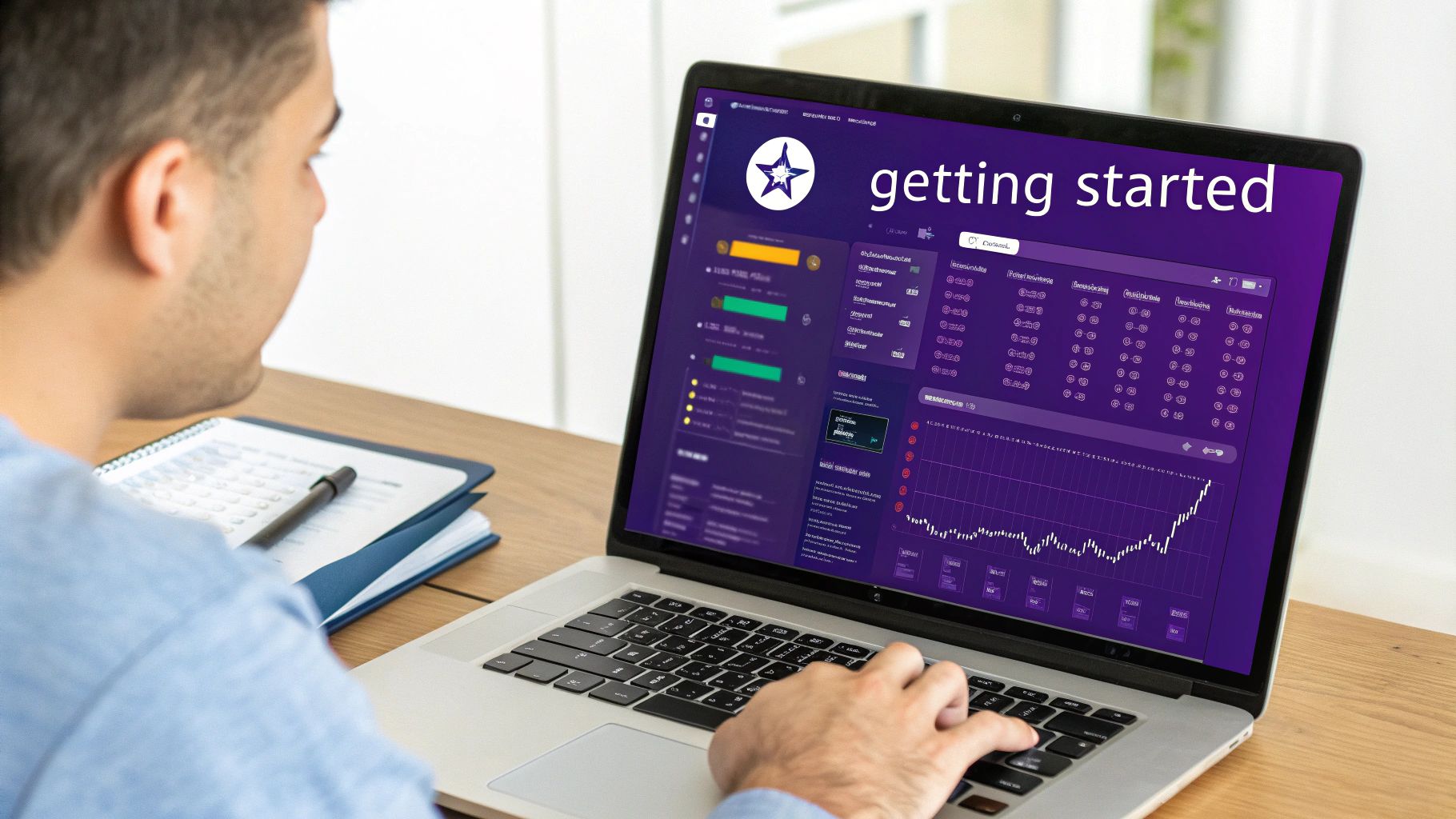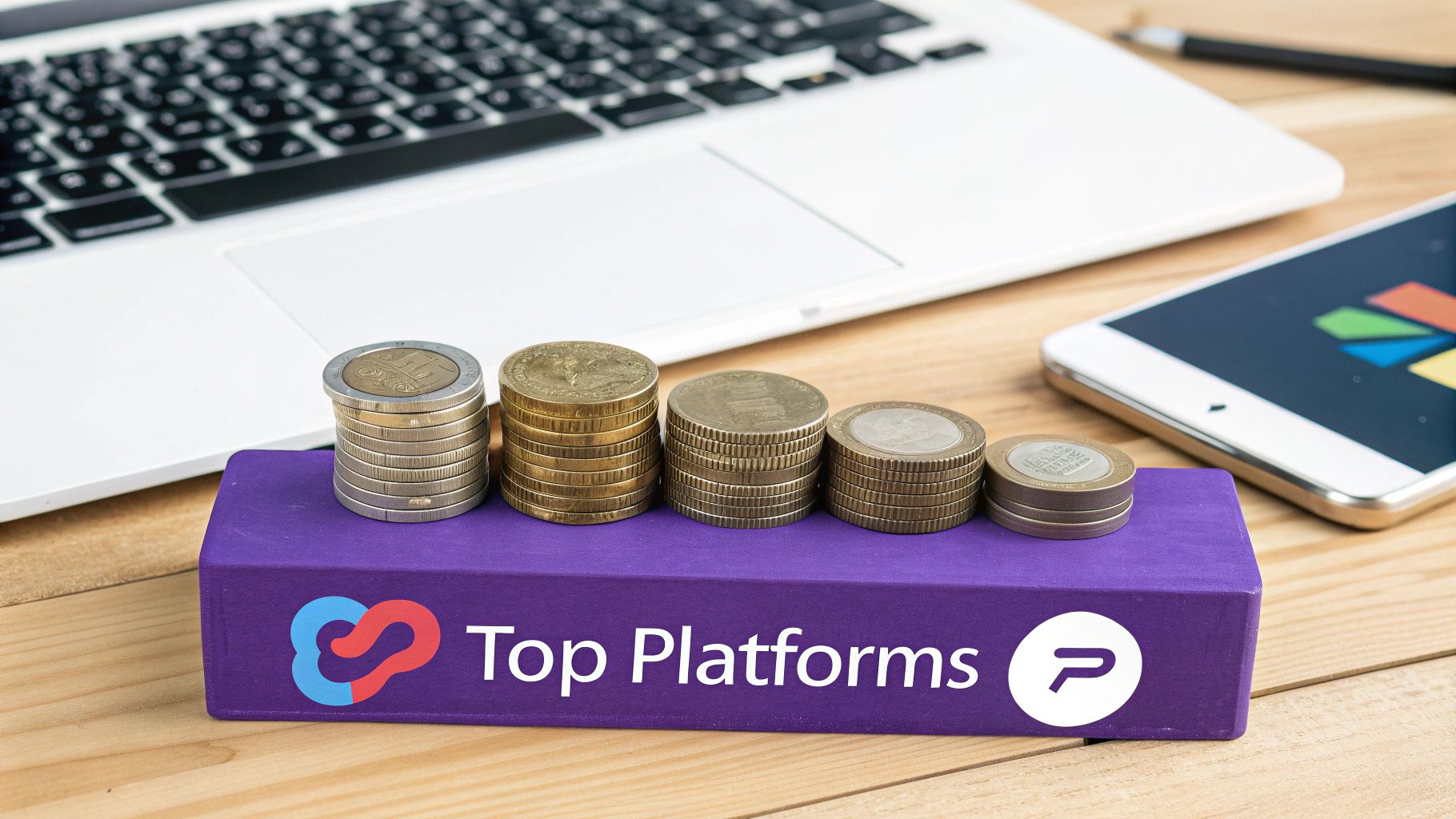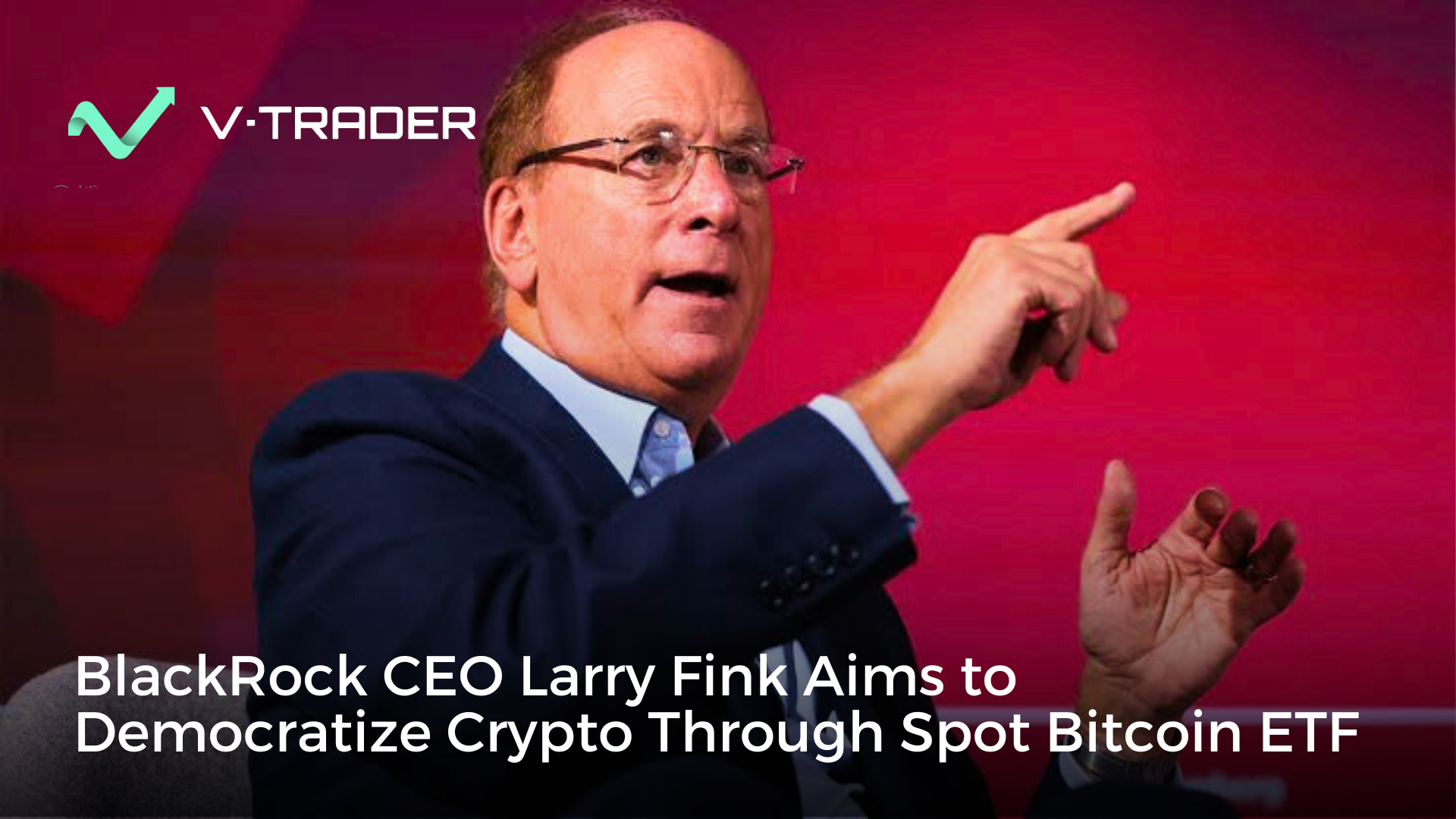Ever wondered how crypto platforms seem to grow so fast? A big part of the magic is something called an affiliate program.
Think of a crypto affiliate program as a partnership. You, as an affiliate, essentially become a brand ambassador for a crypto platform. You get a unique link to share with your audience, and when someone clicks it, signs up, or starts trading, you earn a commission. It’s a classic win-win: the platform gets new, motivated customers, and you open up a new income stream.
How Crypto Affiliate Marketing Really Works
At its heart, this is a growth strategy built on trust. Instead of pouring millions into traditional ads, crypto exchanges reward real people—traders, content creators, and influencers—for bringing engaged users into their ecosystem. It’s a more organic approach that just feels more authentic.
The mechanics are pretty simple. Once you join a program, you get that all-important unique referral link. You also get access to a personal dashboard, which is basically your mission control for tracking everything.
Your Affiliate Dashboard: The Command Center
This dashboard is where you see your efforts pay off in real-time. It’s designed to give you a clear, no-nonsense look at how you're doing, tracking metrics like link clicks, new sign-ups, and the trading volume generated by your referrals.
Here’s a glimpse of what a typical affiliate dashboard looks like:

This kind of data is invaluable. It lets you see which of your strategies are hitting the mark and where you might need to adjust your approach, all based on solid numbers.
Why Are These Programs Exploding in Popularity?
In the fast-paced world of digital assets, affiliate marketing has become a go-to for scaling up. Even with all its ups and downs, the crypto market is a massive $350 billion industry. For platforms to grab a piece of that pie, they need effective ways to grow their user base.
The continued buzz around giants like Bitcoin and Ethereum keeps drawing new people in, creating a constantly expanding audience for affiliates to tap into.
This is exactly why companies like vTrader lean into this model. It helps build a strong, loyal community by rewarding the very people who contribute to its success. With the right program, like the one we’ve built at vTrader, you get the tools and support you need to thrive. It’s all about creating a relationship where both the platform and its partners grow together.
How Crypto Affiliate Programs Actually Work
At first glance, a crypto affiliate program can seem like a complex machine with a lot of moving parts. But when you peel back the layers, the core idea is incredibly simple. Think of it as a digital handshake between you, the crypto platform, and the new trader you bring into the fold. It's all automated, totally transparent, and built from the ground up to reward you for helping the platform grow.
The real magic happens with your unique affiliate link. This isn't just a regular web address; it’s a smart link tagged with a special tracking code—often called a "cookie"—that points right back to you. When someone clicks on it, a tiny piece of data gets saved in their browser for a while, making sure you get the credit when they take action.
This whole journey, from your first shared link to your first payout, breaks down into four straightforward stages.
The Four Stages of Affiliate Success
From the moment you start promoting to the second your commission lands in your account, there's a clear, traceable path. Everything is powered by technology humming away in the background, connecting your hard work directly to your earnings. Getting a handle on this flow is the key to tracking your performance and scaling up.
Here’s a quick visual of how it all connects.

This image nails the core relationship: you promote, a user acts, and you get rewarded. That’s the foundation of any solid affiliate partnership.
To give you a better sense of the workflow, let's map out the entire affiliate journey from start to finish.
The Affiliate Journey from Sign-Up to Payout
| Stage | Affiliate Action | Platform Action |
|---|---|---|
| 1. Sign-Up & Share | Join the program, get your unique affiliate link from your dashboard, and share it in your content (blog, video, social media, etc.). | The platform generates and assigns a unique, trackable link to your account and provides marketing materials. |
| 2. User Click & Register | A potential trader clicks your link, which takes them to the crypto platform. They then decide to create an account. | The platform places a tracking cookie on the user's browser, linking their future actions back to you. |
| 3. Trigger Conversion | The new user you referred completes a key action, like making their first deposit or executing their first trade. | The system detects this "conversion" event and validates that it originated from your unique affiliate link. |
| 4. Payout | You receive a commission, which is often a percentage of the trading fees that user generates over time. | The platform calculates your commission based on the agreed-upon terms and credits it directly to your affiliate account. |
As you can see, the process is designed to be seamless. Your main job is to create compelling content and drive traffic, while the platform handles all the technical heavy lifting of tracking and payouts.
Your Dashboard: The Command Center
All this activity comes together in your affiliate dashboard. This is more than just a place to watch your earnings roll in; it's your command center for strategy. You can track crucial stats like your click-through rate (CTR) and conversion rates to figure out what’s hitting the mark and what isn't.
By keeping a close eye on these metrics, you can start fine-tuning your approach. For example, if you have a really high CTR but your conversions are low, it might mean your audience is hooked but needs a little more help understanding how to get started on the platform.
This data empowers you to make smarter decisions and optimize your campaigns for better results. For an extra edge, you can sync your content strategy with what's happening in the market. Check out the latest analysis and breaking stories on the vTrader news hub. This cycle of promoting, analyzing, and refining is exactly how you build a lasting, profitable income stream.
Understanding Different Commission Structures
How you get paid is the absolute engine of any crypto affiliate program. It's not a one-size-fits-all deal, and the commission structure you sign up for can make a world of difference in your earnings. Are you looking for a quick payout or a steady income stream that grows over time? Nailing this down is key to hitting your financial goals.
The payment models you'll run into usually fall into a few main buckets. It’s a bit like choosing between a salaried job and a pure commission sales gig—one offers predictability, while the other holds the keys to much higher long-term earnings.

Let's dive into the main types you'll see out in the wild.
Revenue Share: The Long Game
Revenue Share, or Rev-Share, is easily the most common model you’ll find in the crypto world. With this setup, you earn a cut of the trading fees generated by every user you refer. This isn't just a one-and-done payment; you keep earning for as long as your referral trades on the platform, often for life.
- Here's how it works: If you bring a new trader to a platform offering a 40% Rev-Share, you pocket 40% of every single transaction fee they pay.
- Who it's for: This is perfect for affiliates who want to build a sustainable, passive income source that keeps paying out month after month.
This model is all about quality over quantity. You're rewarded for bringing in active traders who stick around. The more they trade, the more you earn, creating a powerful compounding effect on your income.
Cost Per Acquisition: The Quick Win
On the other side of the coin, you have Cost Per Acquisition (CPA). This model works completely differently. Instead of a recurring percentage, you get a fixed, one-time payment for each new person who signs up and completes a specific action, like making their first deposit.
Picture this: A program offers a $50 CPA. You get a flat $50 in your pocket for every qualified referral you send their way. It’s fast and predictable, but that's where the earning potential for that user stops.
This structure is a great fit for affiliates who need immediate cash flow and are confident they can drive a high volume of new users.
Weighing Your Options: A Practical Comparison
So, which one should you choose? Let's break it down. A $50 CPA gives you instant gratification. Refer 10 people, and you've made a cool $500. Simple.
But with a 40% Rev-Share, just one active trader could generate $15 a month in commissions for you. Over a year, that single referral earns you $180—and that's just the start. To get a feel for how these fees add up, you can check out vTrader's fee structure.
Ultimately, the choice comes down to your strategy. CPA is for quick wins, while Rev-Share is about building a lasting income stream that can grow far beyond that initial payout. Some platforms even offer a hybrid model, mixing a small CPA with a lower Rev-Share to give you a taste of both worlds.
How to Choose the Right Crypto Affiliate Program
Jumping into a partnership with the wrong crypto affiliate program won't just waste your time—it can seriously tarnish the trust you’ve built with your audience. Making a smart choice right out of the gate is absolutely crucial for any kind of long-term success. Think of it as doing your homework, a checklist to vet potential partners and avoid the obvious red flags.
Your first move should always be to look into the platform's brand reputation. Is this a respected exchange known for its security, or is it a new player with no track record? Pushing a platform with a sketchy history is a fast way to lose your own credibility. A strong brand doesn't just make conversions easier; it ensures your audience has a good experience, too.
Evaluating the Core Offer
Once you’ve confirmed a platform is legit, it's time to dig into the nuts and bolts of their affiliate offer. This is where you separate the truly valuable programs from the ones that look flashy on the surface but don't deliver.
A few key metrics will tell you almost everything you need to know:
- Commission Rates: Look for competitive rates, but more importantly, understand the model. A 50% revenue share on trading fees from a major exchange often blows a high one-time payout from a smaller platform out of the water.
- Cookie Duration: This is a big one. A 30-day cookie means you only get credit if your referral signs up within a month. A 90-day cookie gives them three times as long, which dramatically boosts your chances of a successful conversion.
- Payout Terms: When do you get paid, and how? Look for programs with clear, dependable payout schedules and multiple currency options, whether it’s crypto or fiat.
A program's structure reveals its priorities. Generous, long-term commissions and extended cookie durations show that a platform values its partners and is invested in mutual growth, not just quick sign-ups.
Assessing Support and Resources
Beyond the numbers, the quality of support you get is a huge factor. The best crypto affiliate programs arm you with the tools you need to win. This means high-quality marketing materials like banners and landing pages, a responsive affiliate manager who actually answers your questions, and a clean, functional dashboard for tracking your performance.
Top-tier exchanges really set the standard here. For instance, leading platforms like Binance offer up to 50% commission on trading fees with daily payouts and no referral caps, making them a global favorite. This kind of competition pushes other services to offer attractive terms as well, creating a rich ecosystem where affiliates can find their perfect match. It's always a good idea to research the top programs to see how your options stack up.
Ultimately, choosing the right program is all about alignment. The platform shouldn't just offer great financial incentives; it should also provide services you genuinely believe in. For example, if you value educational content, promoting a platform that offers things like staking guides will feel more authentic to your audience and lead to better, more sustainable results.
Strategies for Promoting Your Affiliate Links
Getting your hands on a great crypto affiliate link is one thing, but getting it in front of the right eyeballs is a whole different ball game. Success isn't about blasting your link across the internet. It’s about building trust and showing people you have something valuable to offer.
Think of yourself less as a salesperson and more as a helpful guide. Your real job is to solve problems and answer the questions your audience is asking. When you get that right, dropping in your affiliate link feels like a natural and helpful next step for them, not a pushy sales pitch.

Create Content That Solves Problems
The best, most lasting way to get traffic to your links is by creating genuinely high-quality content. This is where you can flex your knowledge and build a reputation as a go-to source in the crypto space. Instead of just telling people to "sign up here," show them why it's a good idea.
Here are a few content styles that consistently get results:
- In-Depth Reviews: Go deep. Write a completely honest review of the crypto platform, breaking down its pros, cons, fee structures, and security measures. People appreciate the detail.
- Step-by-Step Tutorials: Create a simple guide showing newcomers how to do something specific, like "How to Make Your First Bitcoin Trade" using the platform. This is incredibly valuable and makes placing your link a no-brainer.
- Comparison Articles: Put the platform head-to-head with its main rivals. An unbiased comparison helps users make a smart choice and cements your status as an authority.
The golden rule is simple: educate, don't just advertise. When your audience genuinely learns something useful from you, they're far more likely to trust your recommendations and use your link.
Choose Your Promotion Channels Wisely
You don't need to be everywhere at once. It’s far smarter to focus your energy on the platforms where your target audience is already hanging out. Just remember that each channel has its own vibe and requires a slightly different way of sharing your link.
If you're looking to really maximize your reach and hit potential referrals from all angles, it's worth putting together a comprehensive modern multi-channel marketing strategy.
Popular Promotion Channels
- A Personal Blog or Website: This is your home turf. A blog gives you total control and is the perfect place to publish those detailed reviews and tutorials that can rank on search engines.
- YouTube Channel: Video is a powerhouse for explaining complicated stuff. A simple screen-recorded tutorial showing someone how to use a trading interface can convert like crazy.
- Targeted Email List: Your email list is a direct line to your biggest fans. You can share exclusive insights, market news, and tutorials that feature your affiliate links without fighting an algorithm.
- Social Media: Use platforms like X (formerly Twitter) or Reddit to jump into conversations, share quick tips, and point people toward your bigger content pieces, like a new blog post or video.
Always Prioritize Transparency
Finally, there’s one rule in affiliate marketing that you just can't bend: be transparent. Always let your audience know you're using affiliate links and that you might earn a commission. This isn't just a legal hoop to jump through in many places; it's the bedrock of building long-term trust.
Most people actually appreciate the honesty. A simple disclaimer right at the start of your content is all you need. Being upfront protects your reputation and shows your audience you respect them—and that’s the most valuable asset you’ll ever have.
Frequently Asked Questions
Jumping into a crypto affiliate program can feel like navigating new territory, and it's natural to have a few questions. We've put together some straight-to-the-point answers for the most common queries we hear, so you can get started with clarity and confidence.
How Much Can I Realistically Earn?
Honestly, there’s no single magic number. Your earnings can be anything from a nice side hustle to a full-time income, but it all boils down to a few key things: the size of your audience, how engaged they are, and how much trading activity your referrals generate.
A newcomer might pull in a few hundred dollars a month to start. On the flip side, a well-known creator who’s built a trusted voice in the crypto space could be looking at thousands. The real secret sauce is consistent effort and promoting a platform you genuinely believe in.
Key Takeaway: The money follows the value. Focus on building a trusted community by sharing genuinely helpful content, and the commissions will come as a natural result.
Do I Need to Be a Crypto Expert to Succeed?
Not at all. You don’t need to be a market wizard or a technical analyst with years of experience. What you do need is a genuine curiosity and a solid grasp of the basics. Your audience will connect with your authentic journey and clear explanations far more than they will with complicated jargon they can't understand.
Think about it this way: the best affiliates are often passionate students of the game themselves. They’re great at breaking down complex crypto ideas into simple, practical advice. Your job isn’t to be a financial advisor; it’s to be a reliable guide. Just share what you know, be honest about what you don't, and you'll build an audience that hangs on your every word.
What Are the Biggest Risks in Crypto Affiliate Marketing?
The single greatest risk isn't to your wallet—it's to your reputation. If you promote a sketchy or unreliable platform, you can vaporize the trust you've worked so hard to build with your audience overnight. That's why doing your homework on any program before you partner with them is an absolute must.
A couple of other things to keep in mind:
- Market Volatility: If your commissions are tied to trading fees (like in a revenue share model), your income can swing with the market's mood swings.
- Regulatory Changes: The crypto world is constantly evolving. New rules can pop up and change how exchanges and their affiliate programs have to operate.
You can get ahead of these challenges by not putting all your eggs in one basket and always, always putting your audience’s interests first. For more specific questions about how our platform works, feel free to check out the official vTrader FAQ page.
Ready to kickstart your affiliate journey with a platform designed for growth? Join the vTrader affiliate program and start earning by introducing your community to the world of zero-fee trading.
Become a vTrader Affiliate Today

Steve Gregory is a lawyer in the United States who specializes in licensing for cryptocurrency companies and products. Steve began his career as an attorney in 2015 but made the switch to working in cryptocurrency full time shortly after joining the original team at Gemini Trust Company, an early cryptocurrency exchange based in New York City. Steve then joined CEX.io and was able to launch their regulated US-based cryptocurrency. Steve then went on to become the CEO at currency.com when he ran for four years and was able to lead currency.com to being fully acquired in 2025.


